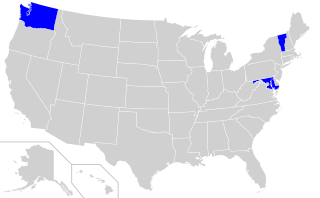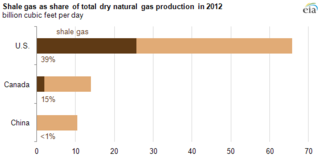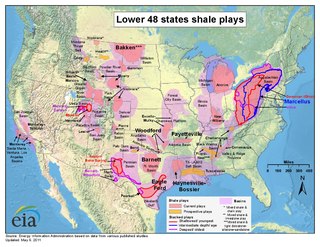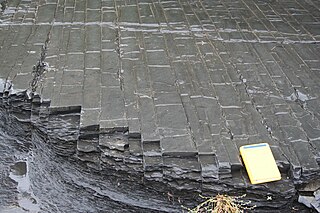
Ovintiv Inc. is a hydrocarbon exploration and production company organized in Delaware and headquartered in Denver, United States. It was founded and headquartered in Calgary, Alberta, and under its previous name Encana was the largest energy company and largest natural gas producer in Canada. The company was rebranded as Ovintiv and relocated to Denver in 2019–20.
Chesapeake Energy Corporation is an American exploration and production company, which is headquartered in Oklahoma City.

The Barnett Shale is a geological formation located in the Bend Arch-Fort Worth Basin. It consists of sedimentary rocks dating from the Mississippian period in Texas. The formation underlies the city of Fort Worth and underlies 5,000 mi² (13,000 km²) and at least 17 counties.

EQT Corporation is an American energy company engaged in hydrocarbon exploration and pipeline transport. It is headquartered in EQT Plaza in Pittsburgh, Pennsylvania.

Hydraulic fracturing in the United States began in 1949. According to the Department of Energy (DOE), by 2013 at least two million oil and gas wells in the US had been hydraulically fractured, and that of new wells being drilled, up to 95% are hydraulically fractured. The output from these wells makes up 43% of the oil production and 67% of the natural gas production in the United States. Environmental safety and health concerns about hydraulic fracturing emerged in the 1980s, and are still being debated at the state and federal levels.

XTO Energy Inc. is an American energy company, principally operating in North America, specializing in the drilling and production of unconventional oil and natural gas assets, typically from shale rock through a process known as hydraulic fracturing. It is a subsidiary of ExxonMobil.

Shale gas is natural gas that is found trapped within shale formations. Since the 1990s a combination of horizontal drilling and hydraulic fracturing has made large volumes of shale gas more economical to produce, and some analysts expect that shale gas will greatly expand worldwide energy supply.

Shale gas in the United States is an available source of natural gas. Led by new applications of hydraulic fracturing technology and horizontal drilling, development of new sources of shale gas has offset declines in production from conventional gas reservoirs, and has led to major increases in reserves of U.S. natural gas. Largely due to shale gas discoveries, estimated reserves of natural gas in the United States in 2008 were 35% higher than in 2006.

The Utica Shale is a stratigraphical unit of Upper Ordovician age in the Appalachian Basin. It underlies much of the northeastern United States and adjacent parts of Canada.

The inclusion of shale gas with conventional gas reserves has caused a sharp increase in estimated recoverable natural gas in Canada. Until the 1990s success of hydraulic fracturing in the Barnett Shales of north Texas, shale gas was classed as "unconventional reserves" and was considered too expensive to recover. There are a number of prospective shale gas deposits in various stages of exploration and exploitation across the country, from British Columbia to Nova Scotia.

Tight oil is light crude oil contained in petroleum-bearing formations of low permeability, often shale or tight sandstone. Economic production from tight oil formations requires the same hydraulic fracturing and often uses the same horizontal well technology used in the production of shale gas. While sometimes called "shale oil", tight oil should not be confused with oil shale or shale oil. Therefore, the International Energy Agency recommends using the term "light tight oil" for oil produced from shales or other very low permeability formations, while the World Energy Resources 2013 report by the World Energy Council uses the terms "tight oil" and "shale-hosted oil".

Hydraulic fracturing, also called fracking, hydrofracking, and hydrofracturing, is a well stimulation technique involving the fracturing of bedrock formations by a pressurized liquid. The process involves the high-pressure injection of "fracking fluid" into a wellbore to create cracks in the deep-rock formations through which natural gas, petroleum, and brine will flow more freely. When the hydraulic pressure is removed from the well, small grains of hydraulic fracturing proppants hold the fractures open.
Shale gas is natural gas produced from shale, a type of sedimentary rock. Shale gas has become an increasingly important source of natural gas in the United States over the past decade, and interest has spread to potential gas shales in Canada, Europe, Asia, and Australia. One analyst expects shale gas to supply as much as half the natural gas production in North America by 2020.

Continental Resources, Inc. is a petroleum and natural gas exploration and production company headquartered in Oklahoma City. The company was founded by Harold Hamm in 1967 at the age of 21 as Shelly Dean Oil Company, originally named for Hamm's two daughters. In 1990, Shelly Dean re-branded itself as Continental Resources. It primarily used hydraulic fracturing and directional drilling to produce from low permeability formations.

Range Resources Corporation is a natural gas exploration and production company headquartered in Fort Worth, Texas. It operates in the Marcellus Formation, where it is one of the largest land owners.

Environmental impact of hydraulic fracturing in the United States has been an issue of public concern, and includes the contamination of ground and surface water, methane emissions, air pollution, migration of gases and hydraulic fracturing chemicals and radionuclides to the surface, the potential mishandling of solid waste, drill cuttings, increased seismicity and associated effects on human and ecosystem health. Research has determined that human health is affected. A number of instances with groundwater contamination have been documented due to well casing failures and illegal disposal practices, including confirmation of chemical, physical, and psychosocial hazards such as pregnancy and birth outcomes, migraine headaches, chronic rhinosinusitis, severe fatigue, asthma exacerbations, and psychological stress. While opponents of water safety regulation claim hydraulic fracturing has never caused any drinking water contamination, adherence to regulation and safety procedures is required to avoid further negative impacts.

The environmental impact of hydraulic fracturing is related to land use and water consumption, air emissions, including methane emissions, brine and fracturing fluid leakage, water contamination, noise pollution, and health. Water and air pollution are the biggest risks to human health from hydraulic fracturing. Research has determined that hydraulic fracturing negatively affects human health and drives climate change.

The Marcellus natural gas trend is a large and prolific area of shale gas extraction from the Marcellus Shale or Marcellus Formation of Devonian age in the eastern United States. The shale play encompasses 104,000 square miles and stretches across Pennsylvania and West Virginia, and into eastern Ohio and western New York. In 2012, it was the largest source of natural gas in the United States, and production was still growing rapidly in 2013. The natural gas is trapped in low-permeability shale, and requires the well completion method of hydraulic fracturing to allow the gas to flow to the well bore. The surge in drilling activity in the Marcellus Shale since 2008 has generated both economic benefits and considerable controversy.

Hydraulic fracturing in Canada was first used in Alberta in 1953 to extract hydrocarbons from the giant Pembina oil field, the biggest conventional oil field in Alberta, which would have produced very little oil without fracturing. Since then, over 170,000 oil and gas wells have been fractured in Western Canada. Hydraulic fracturing is a process that stimulates natural gas or oil in wellbores to flow more easily by subjecting hydrocarbon reservoirs to pressure through the injection of fluids or gas at depth causing the rock to fracture or to widen existing cracks. New hydrocarbon production areas have been opened as hydraulic fracturing stimulating techniques are coupled with more recent advances in horizontal drilling. Complex wells that are many hundreds or thousands of metres below ground are extended even further through drilling of horizontal or directional sections. Massive fracturing has been widely used in Alberta since the late 1970s to recover gas from low-permeability sandstones such as the Spirit River Formation. The productivity of wells in the Cardium, Duvernay, and Viking formations in Alberta, Bakken formation in Saskatchewan, Montney and Horn River formations in British Columbia would not be possible without hydraulic fracturing technology. Hydraulic fracturing has revitalized legacy oilfields. "Hydraulic fracturing of horizontal wells in unconventional shale, silt and tight sand reservoirs unlocks gas, oil and liquids production that until recently was not considered possible." Conventional oil production in Canada was on a decrease since about 2004 but this changed with the increased production from these formations using hydraulic fracturing. Hydraulic fracturing is one of the primary technologies employed to extract shale gas or tight gas from unconventional reservoirs.

Antero Resources Corporation is an American company engaged in hydrocarbon exploration. It is organized in Delaware and headquartered in Denver, Colorado. The company's reserves are entirely in the Appalachian Basin and are extracted using hydraulic fracturing.



















